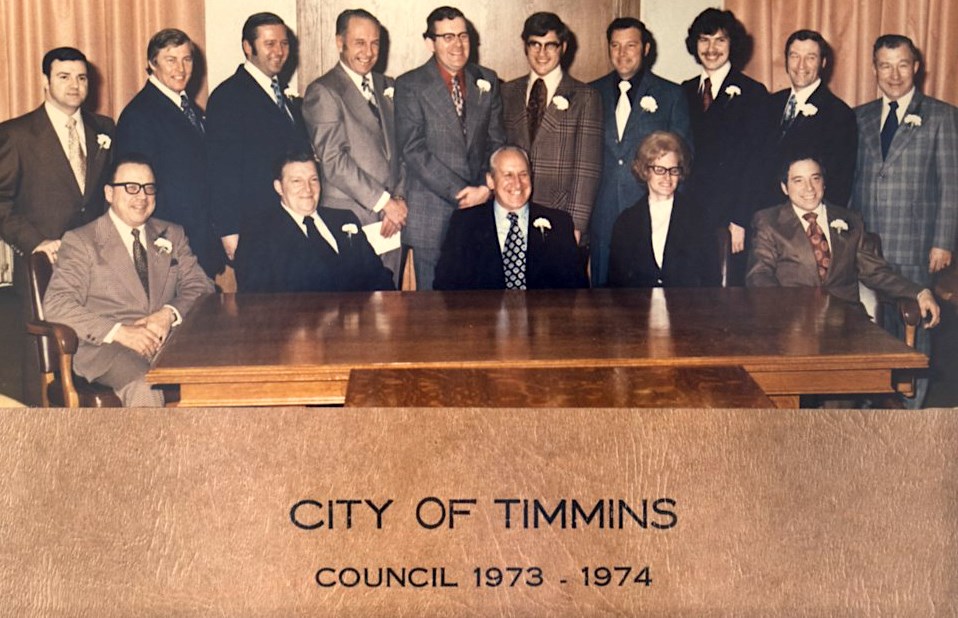The amalgamation of The Porcupine Camp into the City of Timmins was a hot-button local issue. So, it should come as no surprise that selecting a name for the new municipality was also contentious.
The name City of Timmins came about following a vote in October of 1972. But the name game was further proof of the split between the municipalities involved in what was widely seen as a shotgun wedding by the provincial government.
The year 2023 marks the 50th anniversary of amalgamation creating the City of Timmins. Prior to that, the camp included four main municipalities — the Townships of Mountjoy, Tisdale and Whitney, plus the Town of Timmins.
The Ontario government decided to push ahead with amalgamation despite staunch resistance from the three townships. The town was the only municipality in favour of consolidation.
The bill to merge the municipalities received its first reading in Queen’s Park on June 22, 1972. It called for the annexation of 24 unorganized townships and a 16-square-mile portion of Iroquois Falls, in addition to the amalgamation of the four local municipalities. By the time the second reading came on June 27, the province added seven more unorganized townships for a total of 31, plus the Iroquois Falls portion.
This would create a new municipality with a total area of 1,240 square miles — the largest in Canada at the time.
The new city was officially created Jan. 1, 1973, under The Act to Incorporate the City of Timmins-Porcupine.
The road leading to the incorporation of the new city was a rocky one.
Years of discussions, arguments and debates culminated with an announcement made by the provincial government in June 1972 at the McIntyre Community Centre.
“I am convinced that the time has arrived to end the artificial boundaries that have divided this community into separate communities,” said Darcy McKeough, Ontario’s Minister of Intergovernmental Affairs at the time. “I will suggest to you that by uniting this community under a single elected and representative council, it is possible to meet local conditions in the whole area.
“It is my hope that such a council will give all Porcupine area residents a way to decide for themselves on the many local questions that affect their daily lives.”
The announcement was jeered by many. The provincial delegation was greeted by more than 200 protesters outside The Mac, many carrying signs with slogans such as “No Amalgamation” and “Why join Timmins?” Police were at the site ahead of time to make sure the crowd didn’t get unruly.
With the decision made, the citizens of The Porcupine Camp had to elect a new council for the new city.
And there was the matter of naming the city.
Later in June, it was announced the people would name the city. The provincial government had been using the monikers of City of Timmins and Timmins Porcupine up until that point. McKeough’s ministry then opened up the naming to suggestions from the public, which would be voted on during the October municipal elections.
The names on the plebiscite ballot included The City of Timmins, The City of Timmins-Porcupine, and The City of Porcupine.
Not surprisingly, the name Porcupine was favoured by voters in the East End. But voters from the former Town of Timmins, which had a higher population, steadily backed the name Timmins.
The final count was Timmins 10,198 votes, Porcupine 3,591 and Timmins-Porcupine 2,275.
It is estimated 58 per cent of eligible voters turned out to cast ballots in the election. The heaviest turnout for the vote was in the newly created Ward 1 (Mountjoy) at 71 per cent.
The new council was sworn into office in January 1972, with Leo Del Villano as mayor.
RELATED: Larger than life mayor spearheaded growth in Timmins
Del Villano listed two main priorities for the new municipality — both of which are still at the top of modern Timmins’ list.
“I have two priorities, roads and housing,” he said. “They are pretty well even. We have to have more housing.”
The mayor added that it didn’t matter to him which name won in the plebiscite. Although he quipped that he was concerned that more municipal letterhead would have to be changed if Timmins had lost.
The amalgamation came following decades of disputes, including several attempts by the town to annex sections of the townships to increase its population and provincial funding. It was a bitter battle between the townships, town and provincial government right until the end.
Even when it came to the naming of the new city, it must have seemed to Tisdale, Whitney and Mountjoy residents that Timmins got its way once again.
